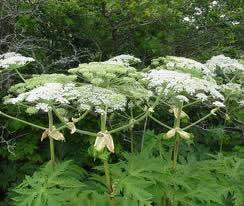Many of us retreat to the garden during the growing season, finding in its toil a pleasure that connects us to the earth. Tending the rich soil, planting seeds, and placing new plants into our garden spaces can have stunning and rewarding results; however, some attractive plant species, namely ‘invasive plants,’ overrun native or non-invasive exotic vegetation to the detriment of surrounding ecosystems.
Why are Invasive Plants a Threat?
Gardeners have been rearranging the world’s flora for centuries, carrying hundreds of plant species from their native ranges to new areas. A small number of these species have resulted in the radical alteration of ecosystems. Invasions cause a decline in biodiversity, and the deterioration of natural resources. Invasive plants also cost taxpayers millions of dollars each year through losses to industry, as impacts are often irreversible and restoration can be extremely difficult and expensive. Some invasive plants even harm our health, cause allergic reactions, and in the worse cases, skin burns.
Preventing Invasive Plants — A Shared Responsibility
As property owners and gardening enthusiasts, we share the responsibility to help prevent the economic losses, environmental damage, and social impacts of invasive plants to our local communities. Practicing ‘smart’ gardening is key to help stop the spread of invasive plants that may be lurking on your property.
Without their natural predators, invasive plants have an advantage over native plants. You may notice how they take over neighbouring plants within a few feet. What you may not see is how their seed and plant fragments drift to new locations in the wind, by birds and pets. Gardeners know all too well that pulling out the one weedy plant early saves a whole lot of pulling later.
How to be 'Garden Smart'
Before you plant a new species in your garden, ask yourself:
- “Will the plant be invasive outside my garden?” Many plant traits that are desirable to gardeners—such as easy germination and rapid establishment, tolerance to drought and frost, rapid growth and abundant seed production—enable a plant species to become invasive and virtually impossible to control.
- “If I order a plant from outside BC, could it be invasive in my environment?” It is possible, although there may be a lag phase before a plant becomes invasive. You will want to check to see if it is listed locally as invasive.
- “What do I need to know from my local nursery or garden centre?” Find out if a plant is a “fast spreader” or a “vigorous self-seeder” in your planting zone. If so, these are warning signs that the species may be invasive.
- “Is there an alternate plant I can use instead of one with the potential to become invasive?” Check the availability of alternative, non-invasive plants suitable for your area. Ask the retailer or refer to the Invasive Species Council of BC’s Grow Me Instead booklet to find suggested alternatives for British Columbia’s most unwanted invasive plants in horticulture (- see Resources).
What Can you Do? Take Action!
Removing invasive plants from your property and establishing a non-invasive garden are great ways to help prevent the spread of invasive plants. To practice SMART gardening:
- S pread knowledge—Make others in your neighbourhood aware of local invasive plants. Contact your local invasive plant committee, gardening group, or nursery to find out which plants are invasive in your area, or call 1-888-WEEDSBC.
- M ake non-invasive plants your first choice when landscaping your property.
- A mputate or dead-head flowers. Pluck single stalks or shear off bunches of flower heads from plants that might become invasive. Removing seeds before they drop saves you time weeding out plants in the spring.
- R emove or dispose of invasive plant parts and seeds responsibly (i.e., bag and landfill or incinerate). Most invasive plants should not be composted. Never dump yard trimmings into natural areas.
- T ake a look. Learn to identify locally important invasive plants. Look closely before buying seeds, especially wildflower, bird, or restoration seed mixtures. Many mixed seeds contain unwanted invaders.
Together is Better!
You can make a difference—get involved with efforts to control invasive plants in your community through your local invasive plant committee, report invasive plants, participate in weed pull events, and support local botanical gardens, nurseries, and gardening clubs that promote, display, or sell non-invasive plants.
Join the Invasive Species Council of BC (ISCBC), a grassroots, non-profit society working collaboratively to build cooperation and coordination of invasive plant management in BC. IPSBC workshops, activities, and events educate the public and professionals about invasive plants, their potential risks and responsible practices. For more information or to become a member (at no cost) visit http://www.bcinvasives.ca/
, email http://www.bcinvasives.ca/contact/isc-office
or call (250) 305-1003 or 1-888-933-3722
Article prepared by the Invasive Species Council of British Columbia

Giant hogweed (Heracleum mantegazzianum) grows up to 5m in height.. Its stem hairs and leaves contain a clear, toxic sap that can cause burns, blisters, and scarring of the skin.

A single hawkweed (Hieracium spp.) plant can produce over 700 root buds during the growing season.
Yellow Flag Iris (Iris pseudacorus) removal is very arduous work. A heavy lift between two crew members is often over 50lbs. Please avoid purchasing or planting yellow flag iris, a highly aggressive, water-loving invasive plant that is still sold in retail outlets




